Strategic Report: Performance Management for High Performance Systems
VerifiedAdded on 2023/01/09
|15
|4294
|75
Report
AI Summary
This strategic report provides a comprehensive analysis of performance management within organizations, focusing on planning, implementing effective policies, and utilizing appropriate techniques to enhance both organizational and employee performance. The report begins with an executive summary and introduction, setting the stage for a detailed exploration of performance management strategies. It examines the importance of performance management in boosting employee engagement, productivity, and overall company results, particularly within Marks and Spencer. The report delves into the implementation of high-performance work systems, emphasizing the role of training, coaching, and constructive feedback. Furthermore, it evaluates the effectiveness of various performance management techniques, including empowering employees, providing continuous coaching, utilizing 360-degree feedback, and conducting performance appraisals. The role of effective communication in addressing employee achievements and underperformance is critically evaluated, highlighting the importance of two-way communication and constructive feedback. Finally, the report provides a critical evaluation of the effectiveness of performance management, drawing conclusions and offering recommendations for improvement.
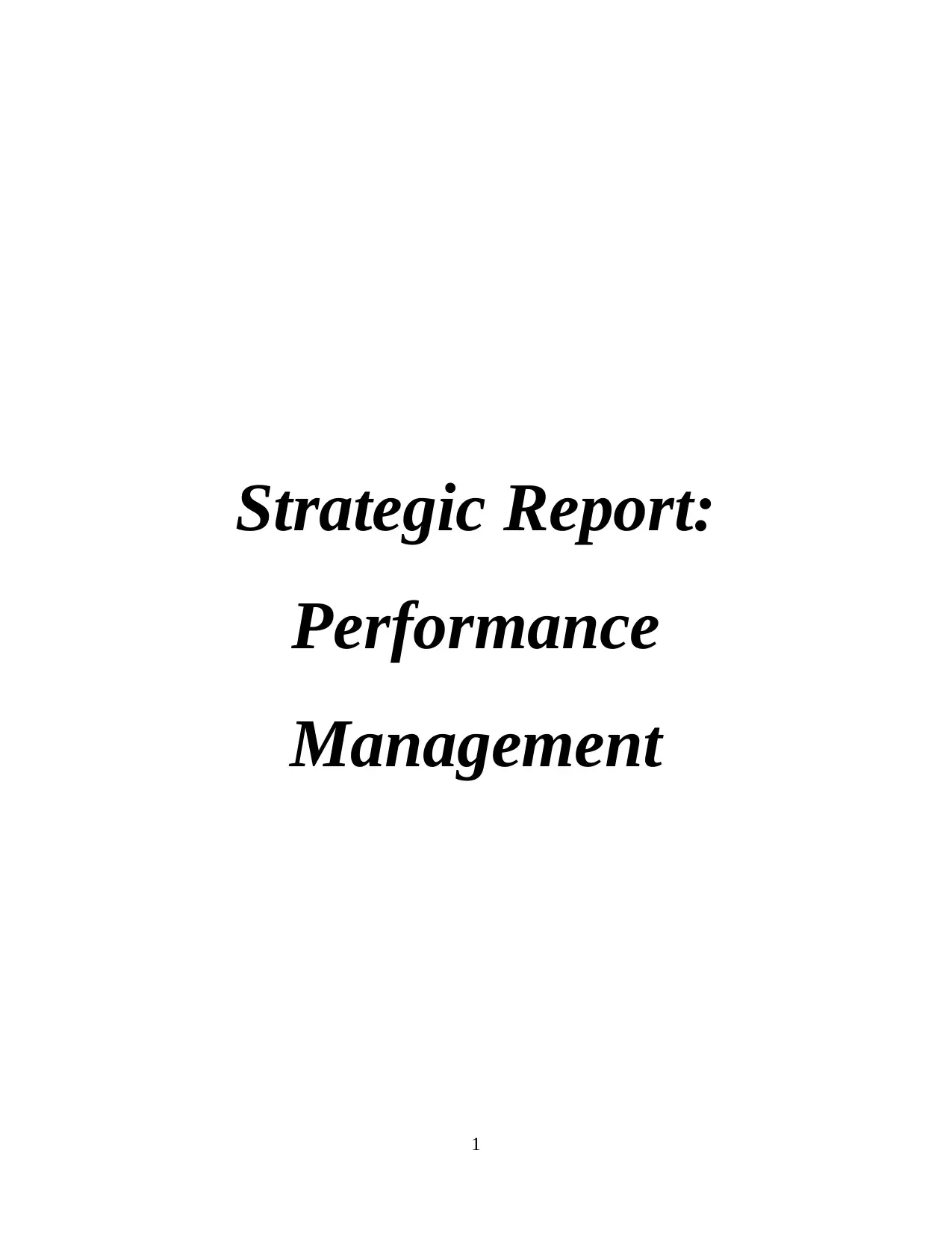
Strategic Report:
Performance
Management
1
Performance
Management
1
Paraphrase This Document
Need a fresh take? Get an instant paraphrase of this document with our AI Paraphraser
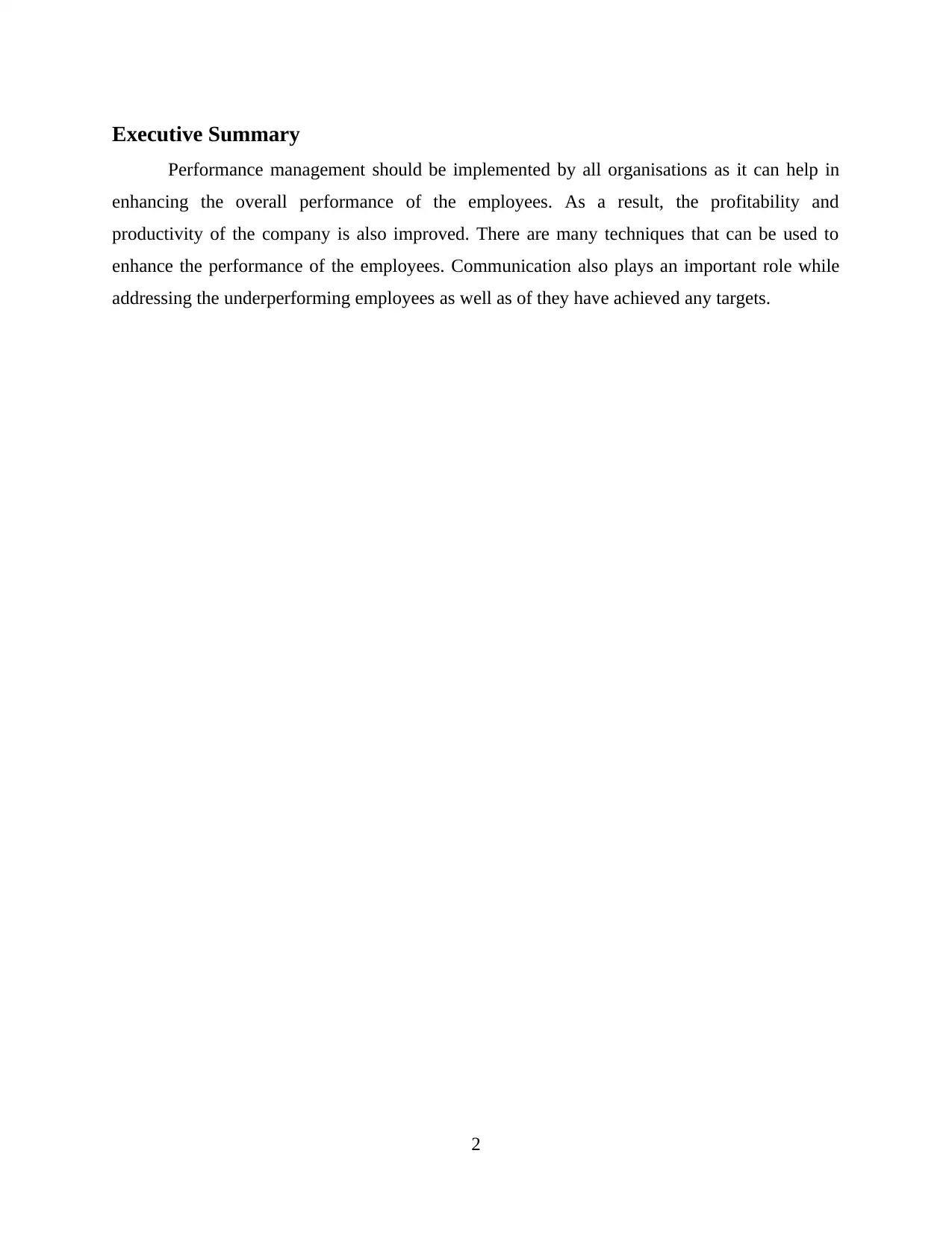
Executive Summary
Performance management should be implemented by all organisations as it can help in
enhancing the overall performance of the employees. As a result, the profitability and
productivity of the company is also improved. There are many techniques that can be used to
enhance the performance of the employees. Communication also plays an important role while
addressing the underperforming employees as well as of they have achieved any targets.
2
Performance management should be implemented by all organisations as it can help in
enhancing the overall performance of the employees. As a result, the profitability and
productivity of the company is also improved. There are many techniques that can be used to
enhance the performance of the employees. Communication also plays an important role while
addressing the underperforming employees as well as of they have achieved any targets.
2
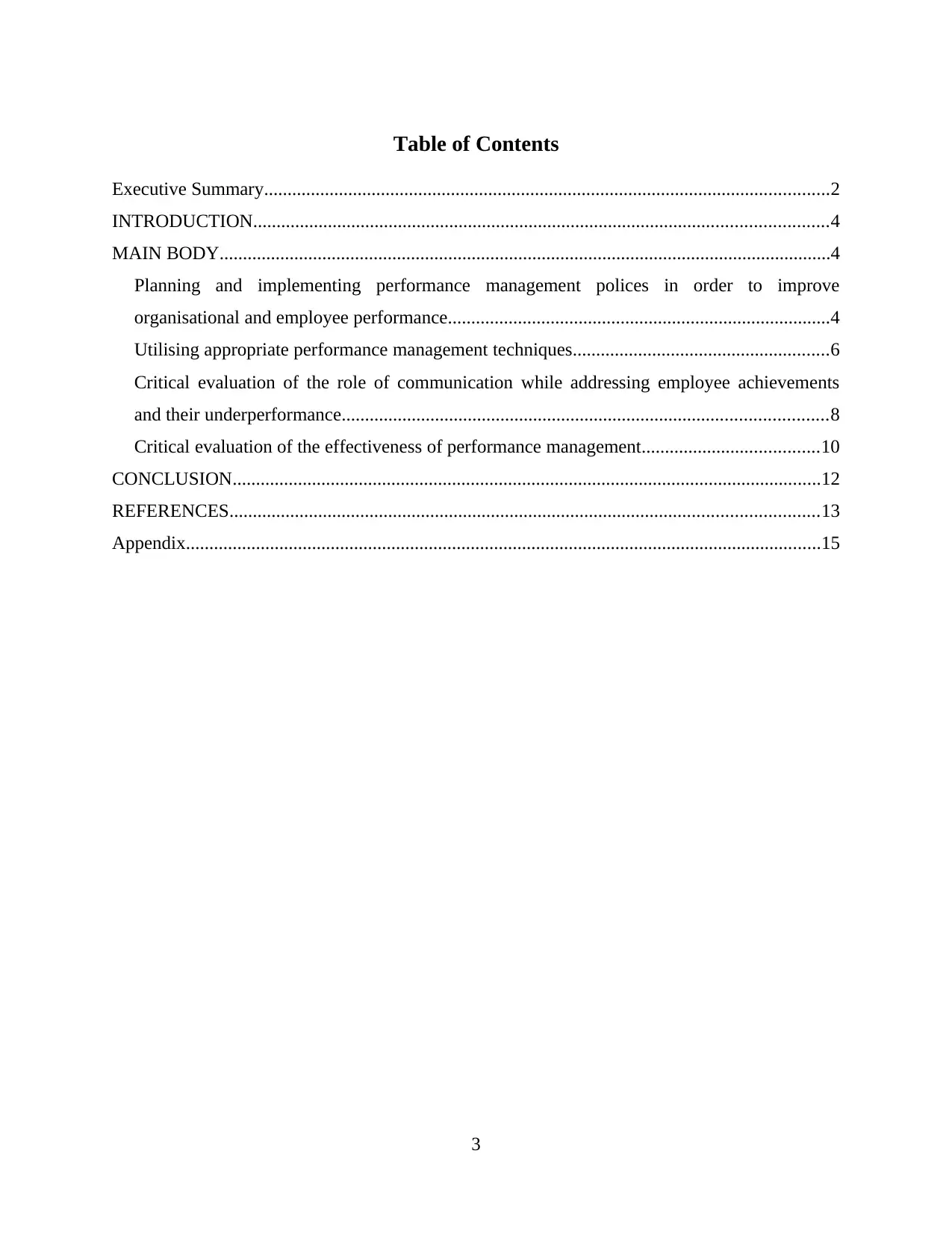
Table of Contents
Executive Summary.........................................................................................................................2
INTRODUCTION...........................................................................................................................4
MAIN BODY...................................................................................................................................4
Planning and implementing performance management polices in order to improve
organisational and employee performance..................................................................................4
Utilising appropriate performance management techniques.......................................................6
Critical evaluation of the role of communication while addressing employee achievements
and their underperformance........................................................................................................8
Critical evaluation of the effectiveness of performance management......................................10
CONCLUSION..............................................................................................................................12
REFERENCES..............................................................................................................................13
Appendix........................................................................................................................................15
3
Executive Summary.........................................................................................................................2
INTRODUCTION...........................................................................................................................4
MAIN BODY...................................................................................................................................4
Planning and implementing performance management polices in order to improve
organisational and employee performance..................................................................................4
Utilising appropriate performance management techniques.......................................................6
Critical evaluation of the role of communication while addressing employee achievements
and their underperformance........................................................................................................8
Critical evaluation of the effectiveness of performance management......................................10
CONCLUSION..............................................................................................................................12
REFERENCES..............................................................................................................................13
Appendix........................................................................................................................................15
3
⊘ This is a preview!⊘
Do you want full access?
Subscribe today to unlock all pages.

Trusted by 1+ million students worldwide
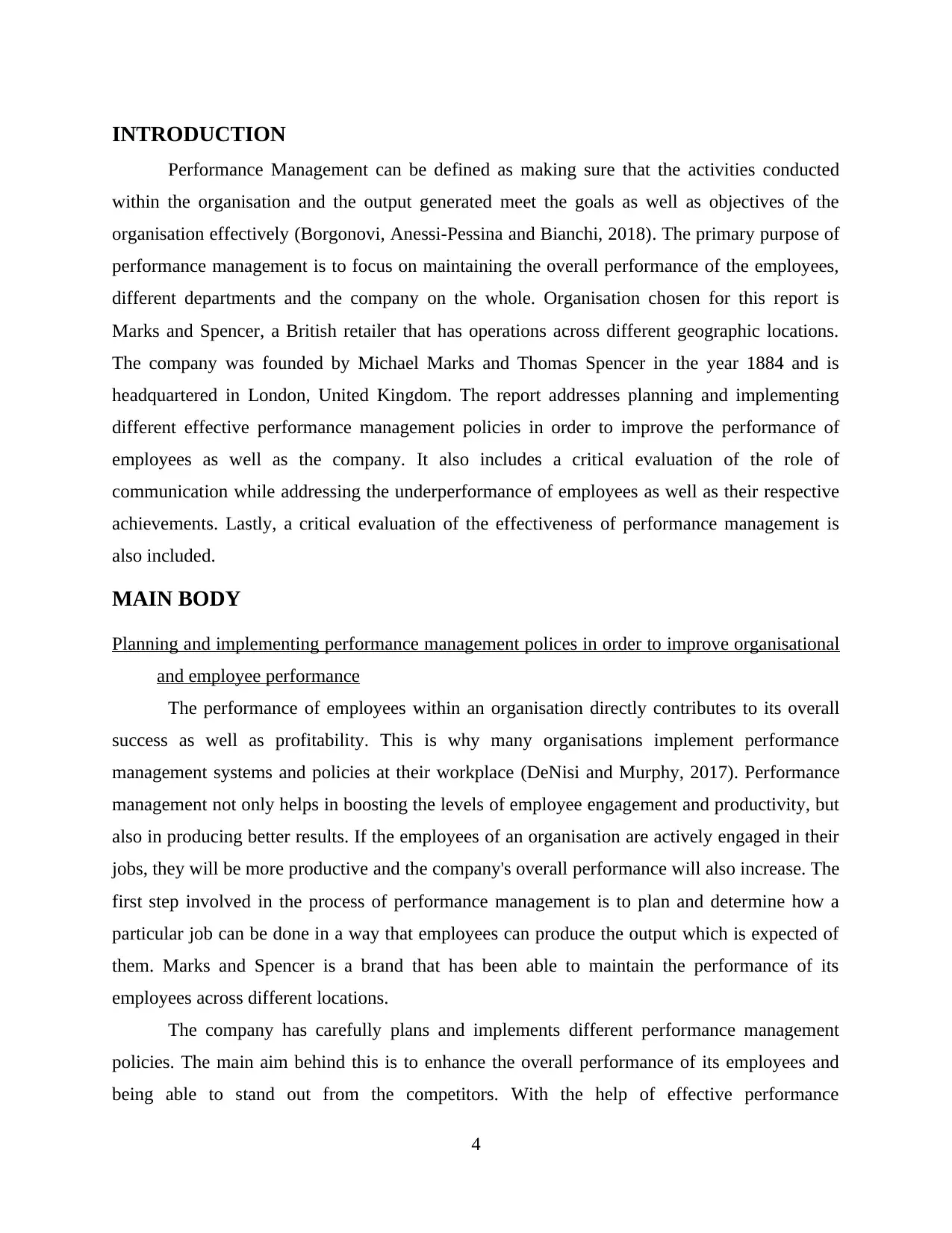
INTRODUCTION
Performance Management can be defined as making sure that the activities conducted
within the organisation and the output generated meet the goals as well as objectives of the
organisation effectively (Borgonovi, Anessi-Pessina and Bianchi, 2018). The primary purpose of
performance management is to focus on maintaining the overall performance of the employees,
different departments and the company on the whole. Organisation chosen for this report is
Marks and Spencer, a British retailer that has operations across different geographic locations.
The company was founded by Michael Marks and Thomas Spencer in the year 1884 and is
headquartered in London, United Kingdom. The report addresses planning and implementing
different effective performance management policies in order to improve the performance of
employees as well as the company. It also includes a critical evaluation of the role of
communication while addressing the underperformance of employees as well as their respective
achievements. Lastly, a critical evaluation of the effectiveness of performance management is
also included.
MAIN BODY
Planning and implementing performance management polices in order to improve organisational
and employee performance
The performance of employees within an organisation directly contributes to its overall
success as well as profitability. This is why many organisations implement performance
management systems and policies at their workplace (DeNisi and Murphy, 2017). Performance
management not only helps in boosting the levels of employee engagement and productivity, but
also in producing better results. If the employees of an organisation are actively engaged in their
jobs, they will be more productive and the company's overall performance will also increase. The
first step involved in the process of performance management is to plan and determine how a
particular job can be done in a way that employees can produce the output which is expected of
them. Marks and Spencer is a brand that has been able to maintain the performance of its
employees across different locations.
The company has carefully plans and implements different performance management
policies. The main aim behind this is to enhance the overall performance of its employees and
being able to stand out from the competitors. With the help of effective performance
4
Performance Management can be defined as making sure that the activities conducted
within the organisation and the output generated meet the goals as well as objectives of the
organisation effectively (Borgonovi, Anessi-Pessina and Bianchi, 2018). The primary purpose of
performance management is to focus on maintaining the overall performance of the employees,
different departments and the company on the whole. Organisation chosen for this report is
Marks and Spencer, a British retailer that has operations across different geographic locations.
The company was founded by Michael Marks and Thomas Spencer in the year 1884 and is
headquartered in London, United Kingdom. The report addresses planning and implementing
different effective performance management policies in order to improve the performance of
employees as well as the company. It also includes a critical evaluation of the role of
communication while addressing the underperformance of employees as well as their respective
achievements. Lastly, a critical evaluation of the effectiveness of performance management is
also included.
MAIN BODY
Planning and implementing performance management polices in order to improve organisational
and employee performance
The performance of employees within an organisation directly contributes to its overall
success as well as profitability. This is why many organisations implement performance
management systems and policies at their workplace (DeNisi and Murphy, 2017). Performance
management not only helps in boosting the levels of employee engagement and productivity, but
also in producing better results. If the employees of an organisation are actively engaged in their
jobs, they will be more productive and the company's overall performance will also increase. The
first step involved in the process of performance management is to plan and determine how a
particular job can be done in a way that employees can produce the output which is expected of
them. Marks and Spencer is a brand that has been able to maintain the performance of its
employees across different locations.
The company has carefully plans and implements different performance management
policies. The main aim behind this is to enhance the overall performance of its employees and
being able to stand out from the competitors. With the help of effective performance
4
Paraphrase This Document
Need a fresh take? Get an instant paraphrase of this document with our AI Paraphraser
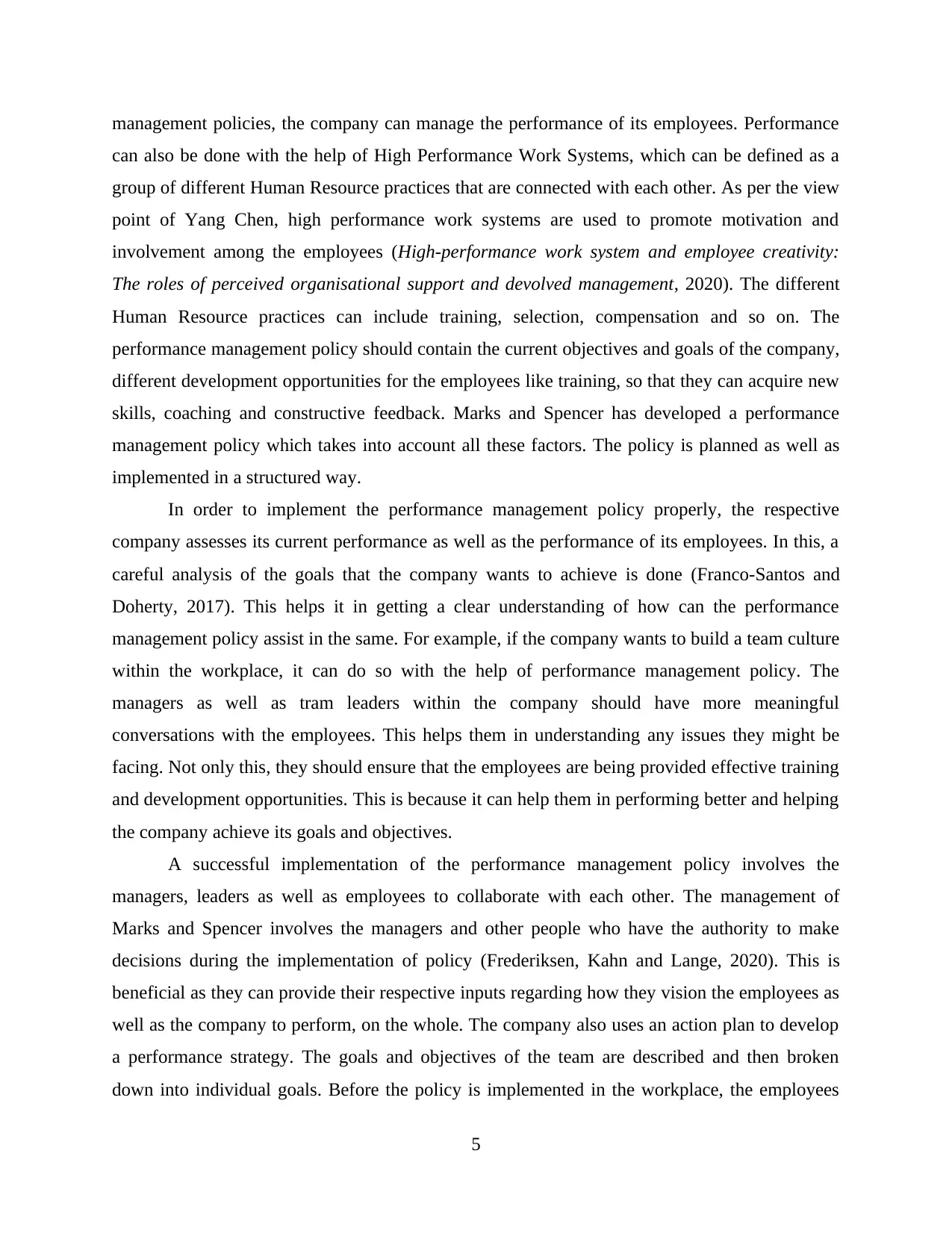
management policies, the company can manage the performance of its employees. Performance
can also be done with the help of High Performance Work Systems, which can be defined as a
group of different Human Resource practices that are connected with each other. As per the view
point of Yang Chen, high performance work systems are used to promote motivation and
involvement among the employees (High-performance work system and employee creativity:
The roles of perceived organisational support and devolved management, 2020). The different
Human Resource practices can include training, selection, compensation and so on. The
performance management policy should contain the current objectives and goals of the company,
different development opportunities for the employees like training, so that they can acquire new
skills, coaching and constructive feedback. Marks and Spencer has developed a performance
management policy which takes into account all these factors. The policy is planned as well as
implemented in a structured way.
In order to implement the performance management policy properly, the respective
company assesses its current performance as well as the performance of its employees. In this, a
careful analysis of the goals that the company wants to achieve is done (Franco-Santos and
Doherty, 2017). This helps it in getting a clear understanding of how can the performance
management policy assist in the same. For example, if the company wants to build a team culture
within the workplace, it can do so with the help of performance management policy. The
managers as well as tram leaders within the company should have more meaningful
conversations with the employees. This helps them in understanding any issues they might be
facing. Not only this, they should ensure that the employees are being provided effective training
and development opportunities. This is because it can help them in performing better and helping
the company achieve its goals and objectives.
A successful implementation of the performance management policy involves the
managers, leaders as well as employees to collaborate with each other. The management of
Marks and Spencer involves the managers and other people who have the authority to make
decisions during the implementation of policy (Frederiksen, Kahn and Lange, 2020). This is
beneficial as they can provide their respective inputs regarding how they vision the employees as
well as the company to perform, on the whole. The company also uses an action plan to develop
a performance strategy. The goals and objectives of the team are described and then broken
down into individual goals. Before the policy is implemented in the workplace, the employees
5
can also be done with the help of High Performance Work Systems, which can be defined as a
group of different Human Resource practices that are connected with each other. As per the view
point of Yang Chen, high performance work systems are used to promote motivation and
involvement among the employees (High-performance work system and employee creativity:
The roles of perceived organisational support and devolved management, 2020). The different
Human Resource practices can include training, selection, compensation and so on. The
performance management policy should contain the current objectives and goals of the company,
different development opportunities for the employees like training, so that they can acquire new
skills, coaching and constructive feedback. Marks and Spencer has developed a performance
management policy which takes into account all these factors. The policy is planned as well as
implemented in a structured way.
In order to implement the performance management policy properly, the respective
company assesses its current performance as well as the performance of its employees. In this, a
careful analysis of the goals that the company wants to achieve is done (Franco-Santos and
Doherty, 2017). This helps it in getting a clear understanding of how can the performance
management policy assist in the same. For example, if the company wants to build a team culture
within the workplace, it can do so with the help of performance management policy. The
managers as well as tram leaders within the company should have more meaningful
conversations with the employees. This helps them in understanding any issues they might be
facing. Not only this, they should ensure that the employees are being provided effective training
and development opportunities. This is because it can help them in performing better and helping
the company achieve its goals and objectives.
A successful implementation of the performance management policy involves the
managers, leaders as well as employees to collaborate with each other. The management of
Marks and Spencer involves the managers and other people who have the authority to make
decisions during the implementation of policy (Frederiksen, Kahn and Lange, 2020). This is
beneficial as they can provide their respective inputs regarding how they vision the employees as
well as the company to perform, on the whole. The company also uses an action plan to develop
a performance strategy. The goals and objectives of the team are described and then broken
down into individual goals. Before the policy is implemented in the workplace, the employees
5
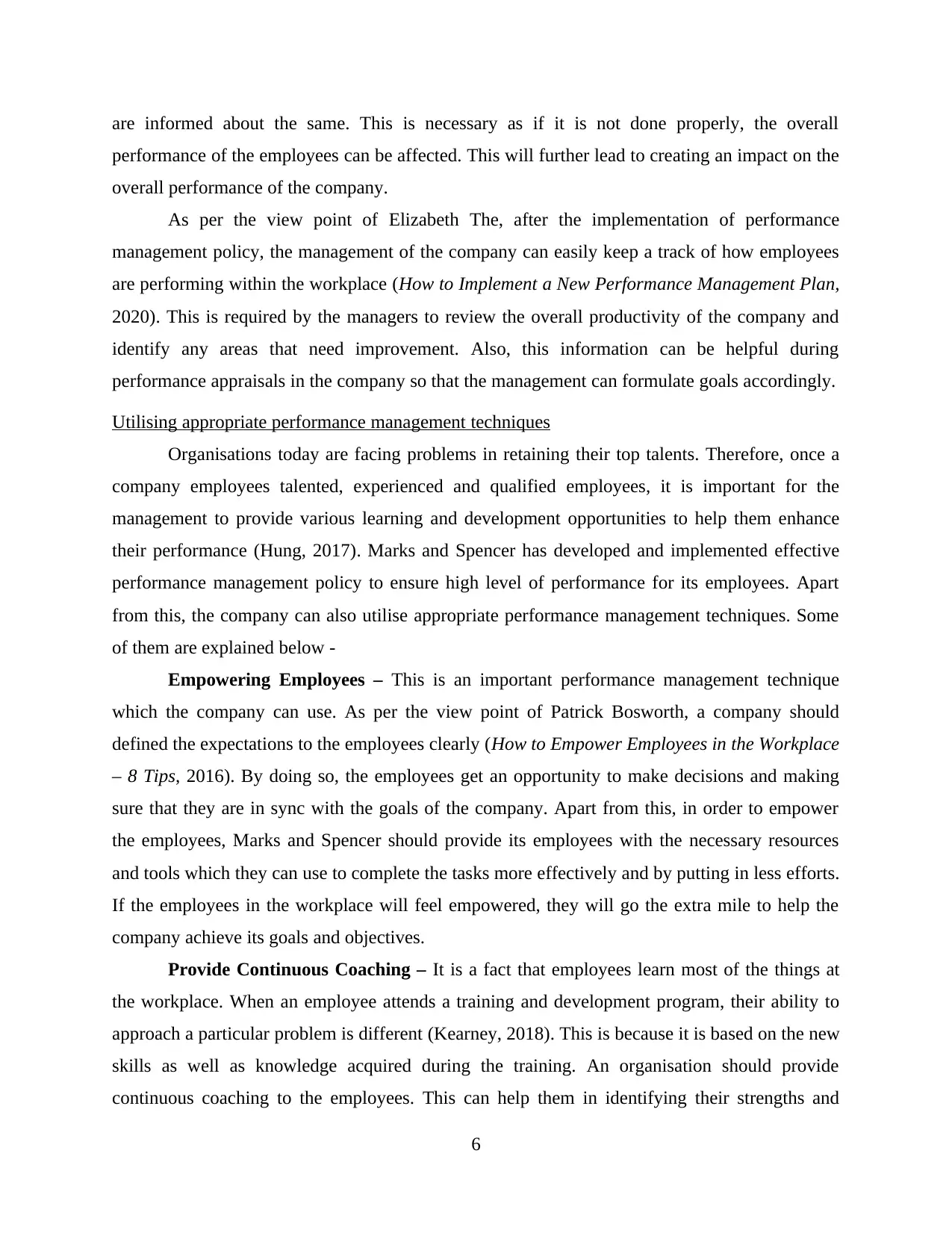
are informed about the same. This is necessary as if it is not done properly, the overall
performance of the employees can be affected. This will further lead to creating an impact on the
overall performance of the company.
As per the view point of Elizabeth The, after the implementation of performance
management policy, the management of the company can easily keep a track of how employees
are performing within the workplace (How to Implement a New Performance Management Plan,
2020). This is required by the managers to review the overall productivity of the company and
identify any areas that need improvement. Also, this information can be helpful during
performance appraisals in the company so that the management can formulate goals accordingly.
Utilising appropriate performance management techniques
Organisations today are facing problems in retaining their top talents. Therefore, once a
company employees talented, experienced and qualified employees, it is important for the
management to provide various learning and development opportunities to help them enhance
their performance (Hung, 2017). Marks and Spencer has developed and implemented effective
performance management policy to ensure high level of performance for its employees. Apart
from this, the company can also utilise appropriate performance management techniques. Some
of them are explained below -
Empowering Employees – This is an important performance management technique
which the company can use. As per the view point of Patrick Bosworth, a company should
defined the expectations to the employees clearly (How to Empower Employees in the Workplace
– 8 Tips, 2016). By doing so, the employees get an opportunity to make decisions and making
sure that they are in sync with the goals of the company. Apart from this, in order to empower
the employees, Marks and Spencer should provide its employees with the necessary resources
and tools which they can use to complete the tasks more effectively and by putting in less efforts.
If the employees in the workplace will feel empowered, they will go the extra mile to help the
company achieve its goals and objectives.
Provide Continuous Coaching – It is a fact that employees learn most of the things at
the workplace. When an employee attends a training and development program, their ability to
approach a particular problem is different (Kearney, 2018). This is because it is based on the new
skills as well as knowledge acquired during the training. An organisation should provide
continuous coaching to the employees. This can help them in identifying their strengths and
6
performance of the employees can be affected. This will further lead to creating an impact on the
overall performance of the company.
As per the view point of Elizabeth The, after the implementation of performance
management policy, the management of the company can easily keep a track of how employees
are performing within the workplace (How to Implement a New Performance Management Plan,
2020). This is required by the managers to review the overall productivity of the company and
identify any areas that need improvement. Also, this information can be helpful during
performance appraisals in the company so that the management can formulate goals accordingly.
Utilising appropriate performance management techniques
Organisations today are facing problems in retaining their top talents. Therefore, once a
company employees talented, experienced and qualified employees, it is important for the
management to provide various learning and development opportunities to help them enhance
their performance (Hung, 2017). Marks and Spencer has developed and implemented effective
performance management policy to ensure high level of performance for its employees. Apart
from this, the company can also utilise appropriate performance management techniques. Some
of them are explained below -
Empowering Employees – This is an important performance management technique
which the company can use. As per the view point of Patrick Bosworth, a company should
defined the expectations to the employees clearly (How to Empower Employees in the Workplace
– 8 Tips, 2016). By doing so, the employees get an opportunity to make decisions and making
sure that they are in sync with the goals of the company. Apart from this, in order to empower
the employees, Marks and Spencer should provide its employees with the necessary resources
and tools which they can use to complete the tasks more effectively and by putting in less efforts.
If the employees in the workplace will feel empowered, they will go the extra mile to help the
company achieve its goals and objectives.
Provide Continuous Coaching – It is a fact that employees learn most of the things at
the workplace. When an employee attends a training and development program, their ability to
approach a particular problem is different (Kearney, 2018). This is because it is based on the new
skills as well as knowledge acquired during the training. An organisation should provide
continuous coaching to the employees. This can help them in identifying their strengths and
6
⊘ This is a preview!⊘
Do you want full access?
Subscribe today to unlock all pages.

Trusted by 1+ million students worldwide
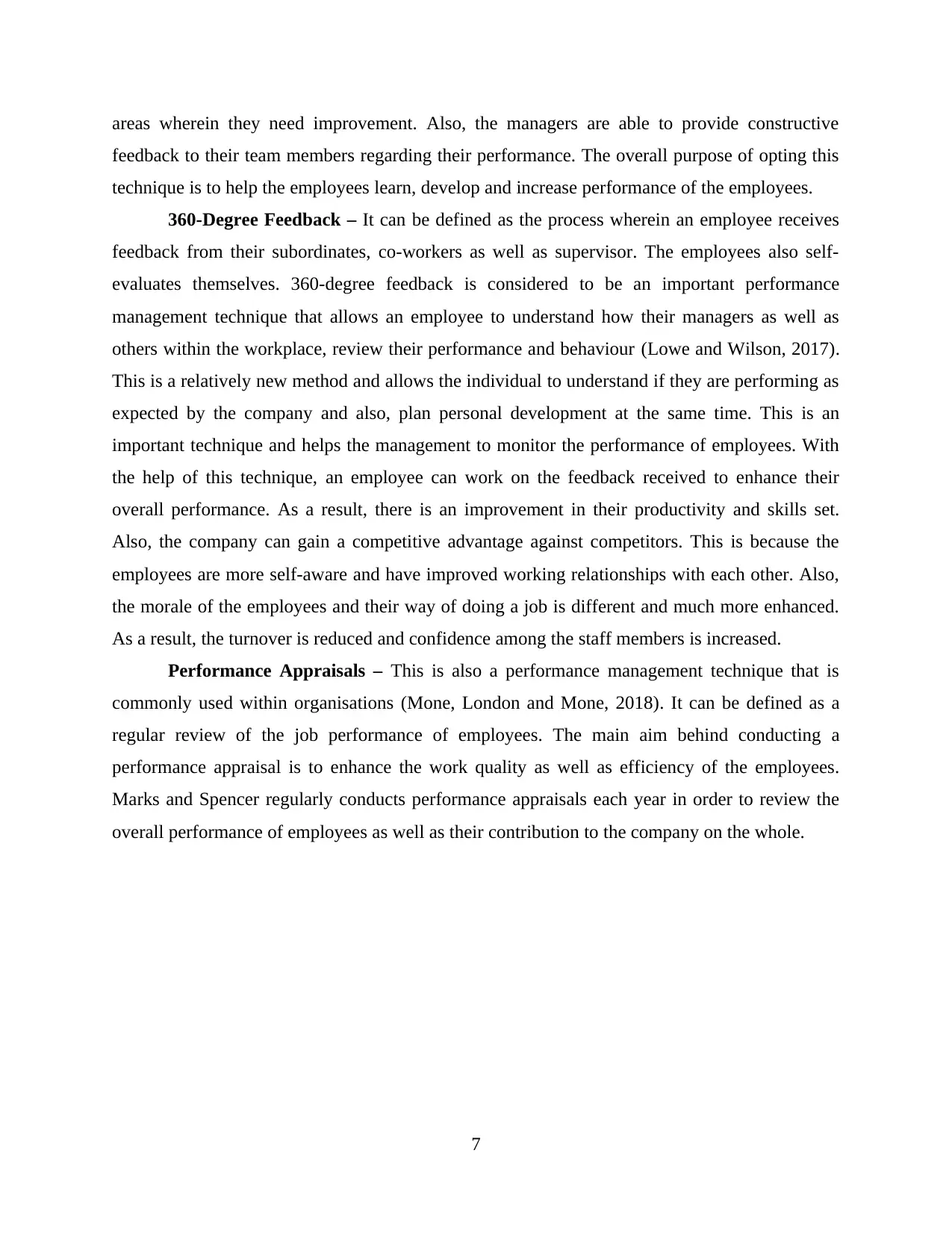
areas wherein they need improvement. Also, the managers are able to provide constructive
feedback to their team members regarding their performance. The overall purpose of opting this
technique is to help the employees learn, develop and increase performance of the employees.
360-Degree Feedback – It can be defined as the process wherein an employee receives
feedback from their subordinates, co-workers as well as supervisor. The employees also self-
evaluates themselves. 360-degree feedback is considered to be an important performance
management technique that allows an employee to understand how their managers as well as
others within the workplace, review their performance and behaviour (Lowe and Wilson, 2017).
This is a relatively new method and allows the individual to understand if they are performing as
expected by the company and also, plan personal development at the same time. This is an
important technique and helps the management to monitor the performance of employees. With
the help of this technique, an employee can work on the feedback received to enhance their
overall performance. As a result, there is an improvement in their productivity and skills set.
Also, the company can gain a competitive advantage against competitors. This is because the
employees are more self-aware and have improved working relationships with each other. Also,
the morale of the employees and their way of doing a job is different and much more enhanced.
As a result, the turnover is reduced and confidence among the staff members is increased.
Performance Appraisals – This is also a performance management technique that is
commonly used within organisations (Mone, London and Mone, 2018). It can be defined as a
regular review of the job performance of employees. The main aim behind conducting a
performance appraisal is to enhance the work quality as well as efficiency of the employees.
Marks and Spencer regularly conducts performance appraisals each year in order to review the
overall performance of employees as well as their contribution to the company on the whole.
7
feedback to their team members regarding their performance. The overall purpose of opting this
technique is to help the employees learn, develop and increase performance of the employees.
360-Degree Feedback – It can be defined as the process wherein an employee receives
feedback from their subordinates, co-workers as well as supervisor. The employees also self-
evaluates themselves. 360-degree feedback is considered to be an important performance
management technique that allows an employee to understand how their managers as well as
others within the workplace, review their performance and behaviour (Lowe and Wilson, 2017).
This is a relatively new method and allows the individual to understand if they are performing as
expected by the company and also, plan personal development at the same time. This is an
important technique and helps the management to monitor the performance of employees. With
the help of this technique, an employee can work on the feedback received to enhance their
overall performance. As a result, there is an improvement in their productivity and skills set.
Also, the company can gain a competitive advantage against competitors. This is because the
employees are more self-aware and have improved working relationships with each other. Also,
the morale of the employees and their way of doing a job is different and much more enhanced.
As a result, the turnover is reduced and confidence among the staff members is increased.
Performance Appraisals – This is also a performance management technique that is
commonly used within organisations (Mone, London and Mone, 2018). It can be defined as a
regular review of the job performance of employees. The main aim behind conducting a
performance appraisal is to enhance the work quality as well as efficiency of the employees.
Marks and Spencer regularly conducts performance appraisals each year in order to review the
overall performance of employees as well as their contribution to the company on the whole.
7
Paraphrase This Document
Need a fresh take? Get an instant paraphrase of this document with our AI Paraphraser
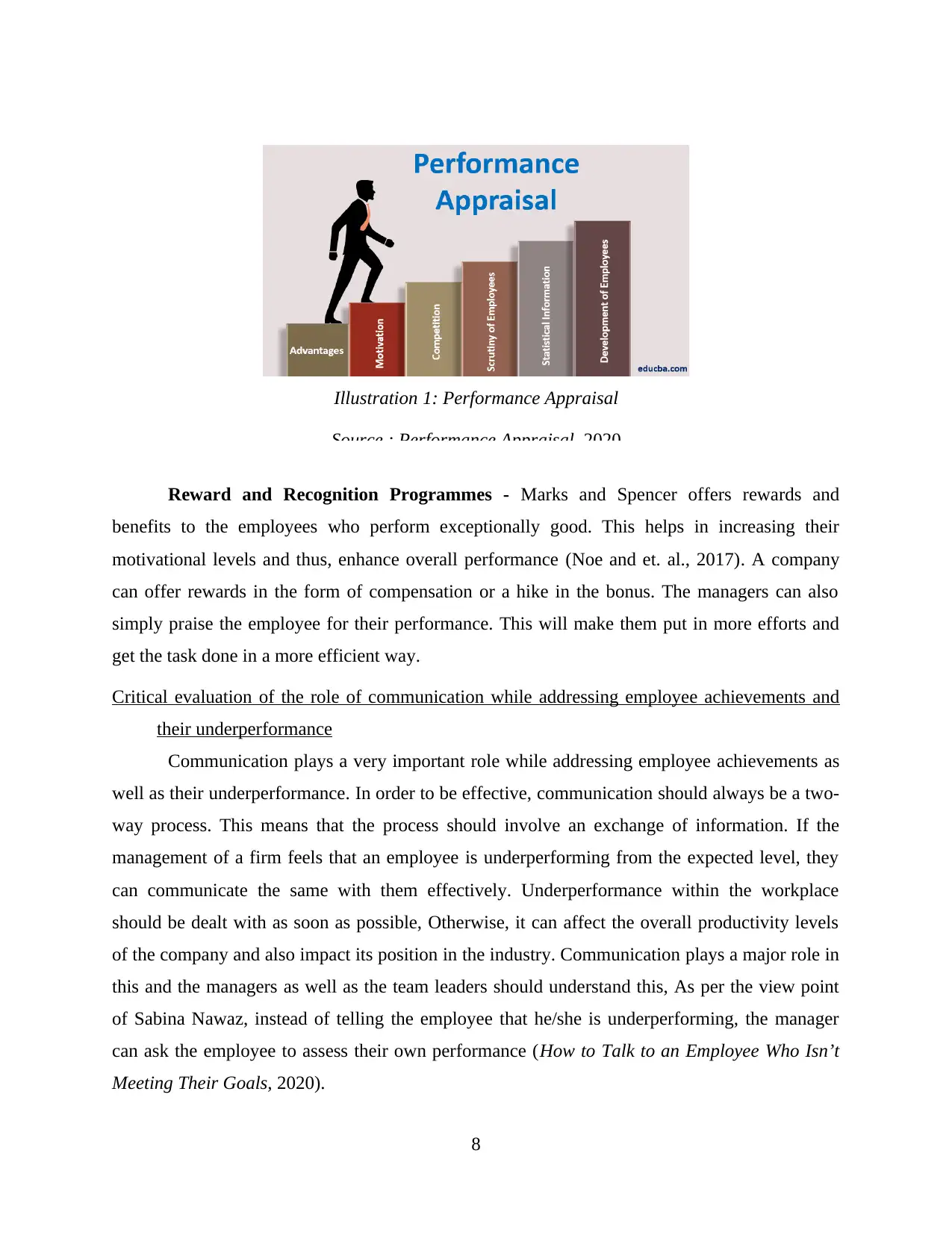
Reward and Recognition Programmes - Marks and Spencer offers rewards and
benefits to the employees who perform exceptionally good. This helps in increasing their
motivational levels and thus, enhance overall performance (Noe and et. al., 2017). A company
can offer rewards in the form of compensation or a hike in the bonus. The managers can also
simply praise the employee for their performance. This will make them put in more efforts and
get the task done in a more efficient way.
Critical evaluation of the role of communication while addressing employee achievements and
their underperformance
Communication plays a very important role while addressing employee achievements as
well as their underperformance. In order to be effective, communication should always be a two-
way process. This means that the process should involve an exchange of information. If the
management of a firm feels that an employee is underperforming from the expected level, they
can communicate the same with them effectively. Underperformance within the workplace
should be dealt with as soon as possible, Otherwise, it can affect the overall productivity levels
of the company and also impact its position in the industry. Communication plays a major role in
this and the managers as well as the team leaders should understand this, As per the view point
of Sabina Nawaz, instead of telling the employee that he/she is underperforming, the manager
can ask the employee to assess their own performance (How to Talk to an Employee Who Isn’t
Meeting Their Goals, 2020).
8
Illustration 1: Performance Appraisal
Source : Performance Appraisal, 2020
benefits to the employees who perform exceptionally good. This helps in increasing their
motivational levels and thus, enhance overall performance (Noe and et. al., 2017). A company
can offer rewards in the form of compensation or a hike in the bonus. The managers can also
simply praise the employee for their performance. This will make them put in more efforts and
get the task done in a more efficient way.
Critical evaluation of the role of communication while addressing employee achievements and
their underperformance
Communication plays a very important role while addressing employee achievements as
well as their underperformance. In order to be effective, communication should always be a two-
way process. This means that the process should involve an exchange of information. If the
management of a firm feels that an employee is underperforming from the expected level, they
can communicate the same with them effectively. Underperformance within the workplace
should be dealt with as soon as possible, Otherwise, it can affect the overall productivity levels
of the company and also impact its position in the industry. Communication plays a major role in
this and the managers as well as the team leaders should understand this, As per the view point
of Sabina Nawaz, instead of telling the employee that he/she is underperforming, the manager
can ask the employee to assess their own performance (How to Talk to an Employee Who Isn’t
Meeting Their Goals, 2020).
8
Illustration 1: Performance Appraisal
Source : Performance Appraisal, 2020
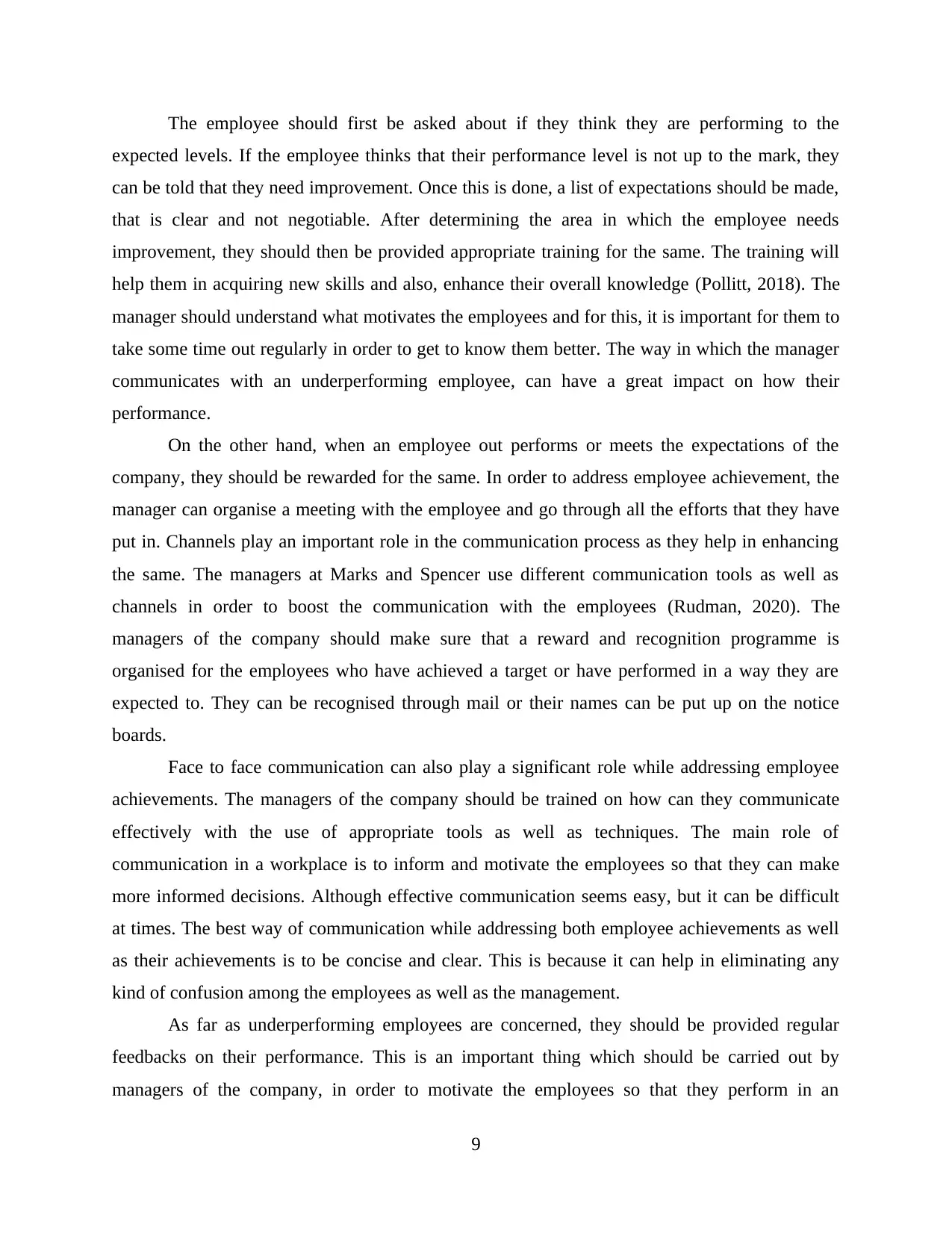
The employee should first be asked about if they think they are performing to the
expected levels. If the employee thinks that their performance level is not up to the mark, they
can be told that they need improvement. Once this is done, a list of expectations should be made,
that is clear and not negotiable. After determining the area in which the employee needs
improvement, they should then be provided appropriate training for the same. The training will
help them in acquiring new skills and also, enhance their overall knowledge (Pollitt, 2018). The
manager should understand what motivates the employees and for this, it is important for them to
take some time out regularly in order to get to know them better. The way in which the manager
communicates with an underperforming employee, can have a great impact on how their
performance.
On the other hand, when an employee out performs or meets the expectations of the
company, they should be rewarded for the same. In order to address employee achievement, the
manager can organise a meeting with the employee and go through all the efforts that they have
put in. Channels play an important role in the communication process as they help in enhancing
the same. The managers at Marks and Spencer use different communication tools as well as
channels in order to boost the communication with the employees (Rudman, 2020). The
managers of the company should make sure that a reward and recognition programme is
organised for the employees who have achieved a target or have performed in a way they are
expected to. They can be recognised through mail or their names can be put up on the notice
boards.
Face to face communication can also play a significant role while addressing employee
achievements. The managers of the company should be trained on how can they communicate
effectively with the use of appropriate tools as well as techniques. The main role of
communication in a workplace is to inform and motivate the employees so that they can make
more informed decisions. Although effective communication seems easy, but it can be difficult
at times. The best way of communication while addressing both employee achievements as well
as their achievements is to be concise and clear. This is because it can help in eliminating any
kind of confusion among the employees as well as the management.
As far as underperforming employees are concerned, they should be provided regular
feedbacks on their performance. This is an important thing which should be carried out by
managers of the company, in order to motivate the employees so that they perform in an
9
expected levels. If the employee thinks that their performance level is not up to the mark, they
can be told that they need improvement. Once this is done, a list of expectations should be made,
that is clear and not negotiable. After determining the area in which the employee needs
improvement, they should then be provided appropriate training for the same. The training will
help them in acquiring new skills and also, enhance their overall knowledge (Pollitt, 2018). The
manager should understand what motivates the employees and for this, it is important for them to
take some time out regularly in order to get to know them better. The way in which the manager
communicates with an underperforming employee, can have a great impact on how their
performance.
On the other hand, when an employee out performs or meets the expectations of the
company, they should be rewarded for the same. In order to address employee achievement, the
manager can organise a meeting with the employee and go through all the efforts that they have
put in. Channels play an important role in the communication process as they help in enhancing
the same. The managers at Marks and Spencer use different communication tools as well as
channels in order to boost the communication with the employees (Rudman, 2020). The
managers of the company should make sure that a reward and recognition programme is
organised for the employees who have achieved a target or have performed in a way they are
expected to. They can be recognised through mail or their names can be put up on the notice
boards.
Face to face communication can also play a significant role while addressing employee
achievements. The managers of the company should be trained on how can they communicate
effectively with the use of appropriate tools as well as techniques. The main role of
communication in a workplace is to inform and motivate the employees so that they can make
more informed decisions. Although effective communication seems easy, but it can be difficult
at times. The best way of communication while addressing both employee achievements as well
as their achievements is to be concise and clear. This is because it can help in eliminating any
kind of confusion among the employees as well as the management.
As far as underperforming employees are concerned, they should be provided regular
feedbacks on their performance. This is an important thing which should be carried out by
managers of the company, in order to motivate the employees so that they perform in an
9
⊘ This is a preview!⊘
Do you want full access?
Subscribe today to unlock all pages.

Trusted by 1+ million students worldwide
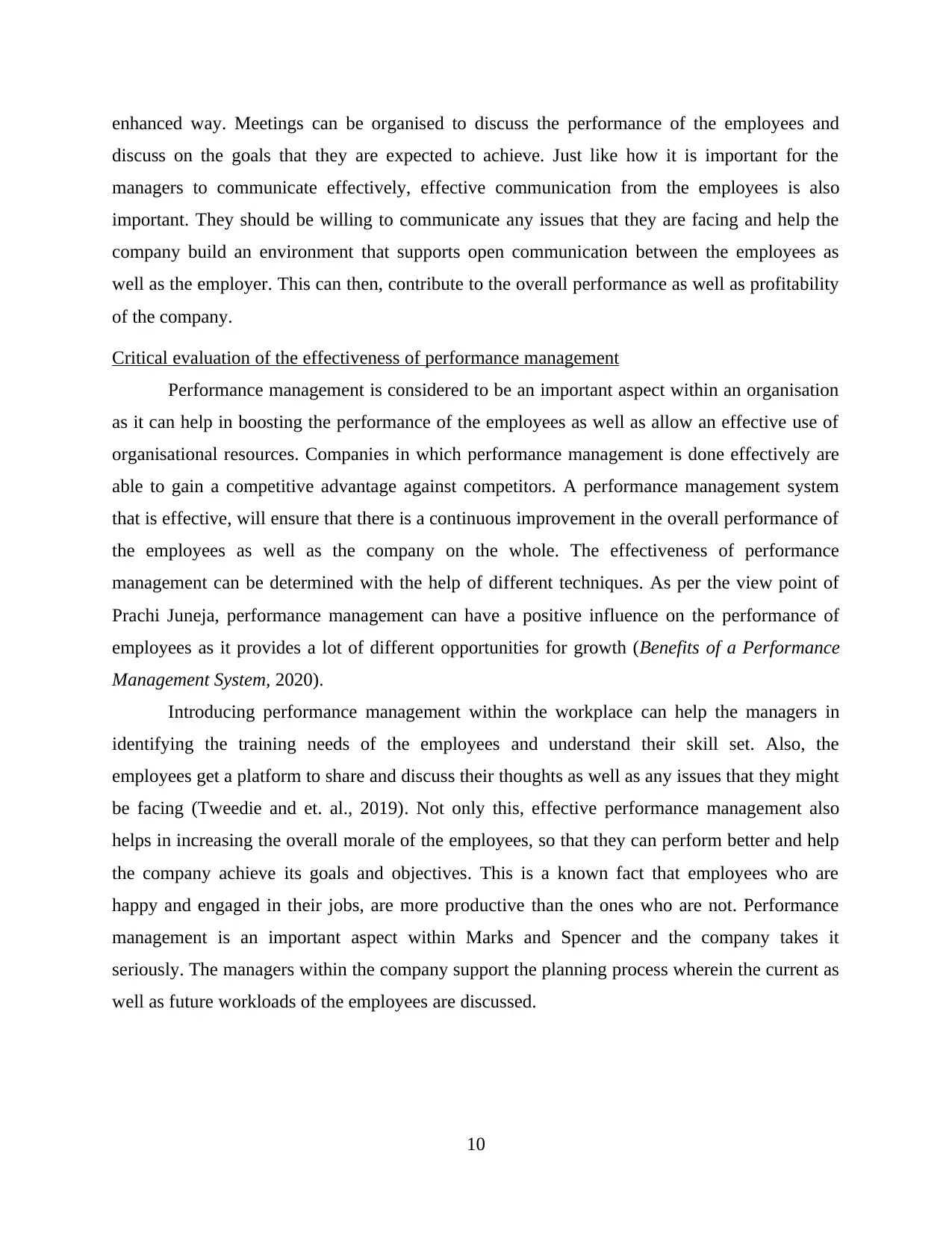
enhanced way. Meetings can be organised to discuss the performance of the employees and
discuss on the goals that they are expected to achieve. Just like how it is important for the
managers to communicate effectively, effective communication from the employees is also
important. They should be willing to communicate any issues that they are facing and help the
company build an environment that supports open communication between the employees as
well as the employer. This can then, contribute to the overall performance as well as profitability
of the company.
Critical evaluation of the effectiveness of performance management
Performance management is considered to be an important aspect within an organisation
as it can help in boosting the performance of the employees as well as allow an effective use of
organisational resources. Companies in which performance management is done effectively are
able to gain a competitive advantage against competitors. A performance management system
that is effective, will ensure that there is a continuous improvement in the overall performance of
the employees as well as the company on the whole. The effectiveness of performance
management can be determined with the help of different techniques. As per the view point of
Prachi Juneja, performance management can have a positive influence on the performance of
employees as it provides a lot of different opportunities for growth (Benefits of a Performance
Management System, 2020).
Introducing performance management within the workplace can help the managers in
identifying the training needs of the employees and understand their skill set. Also, the
employees get a platform to share and discuss their thoughts as well as any issues that they might
be facing (Tweedie and et. al., 2019). Not only this, effective performance management also
helps in increasing the overall morale of the employees, so that they can perform better and help
the company achieve its goals and objectives. This is a known fact that employees who are
happy and engaged in their jobs, are more productive than the ones who are not. Performance
management is an important aspect within Marks and Spencer and the company takes it
seriously. The managers within the company support the planning process wherein the current as
well as future workloads of the employees are discussed.
10
discuss on the goals that they are expected to achieve. Just like how it is important for the
managers to communicate effectively, effective communication from the employees is also
important. They should be willing to communicate any issues that they are facing and help the
company build an environment that supports open communication between the employees as
well as the employer. This can then, contribute to the overall performance as well as profitability
of the company.
Critical evaluation of the effectiveness of performance management
Performance management is considered to be an important aspect within an organisation
as it can help in boosting the performance of the employees as well as allow an effective use of
organisational resources. Companies in which performance management is done effectively are
able to gain a competitive advantage against competitors. A performance management system
that is effective, will ensure that there is a continuous improvement in the overall performance of
the employees as well as the company on the whole. The effectiveness of performance
management can be determined with the help of different techniques. As per the view point of
Prachi Juneja, performance management can have a positive influence on the performance of
employees as it provides a lot of different opportunities for growth (Benefits of a Performance
Management System, 2020).
Introducing performance management within the workplace can help the managers in
identifying the training needs of the employees and understand their skill set. Also, the
employees get a platform to share and discuss their thoughts as well as any issues that they might
be facing (Tweedie and et. al., 2019). Not only this, effective performance management also
helps in increasing the overall morale of the employees, so that they can perform better and help
the company achieve its goals and objectives. This is a known fact that employees who are
happy and engaged in their jobs, are more productive than the ones who are not. Performance
management is an important aspect within Marks and Spencer and the company takes it
seriously. The managers within the company support the planning process wherein the current as
well as future workloads of the employees are discussed.
10
Paraphrase This Document
Need a fresh take? Get an instant paraphrase of this document with our AI Paraphraser
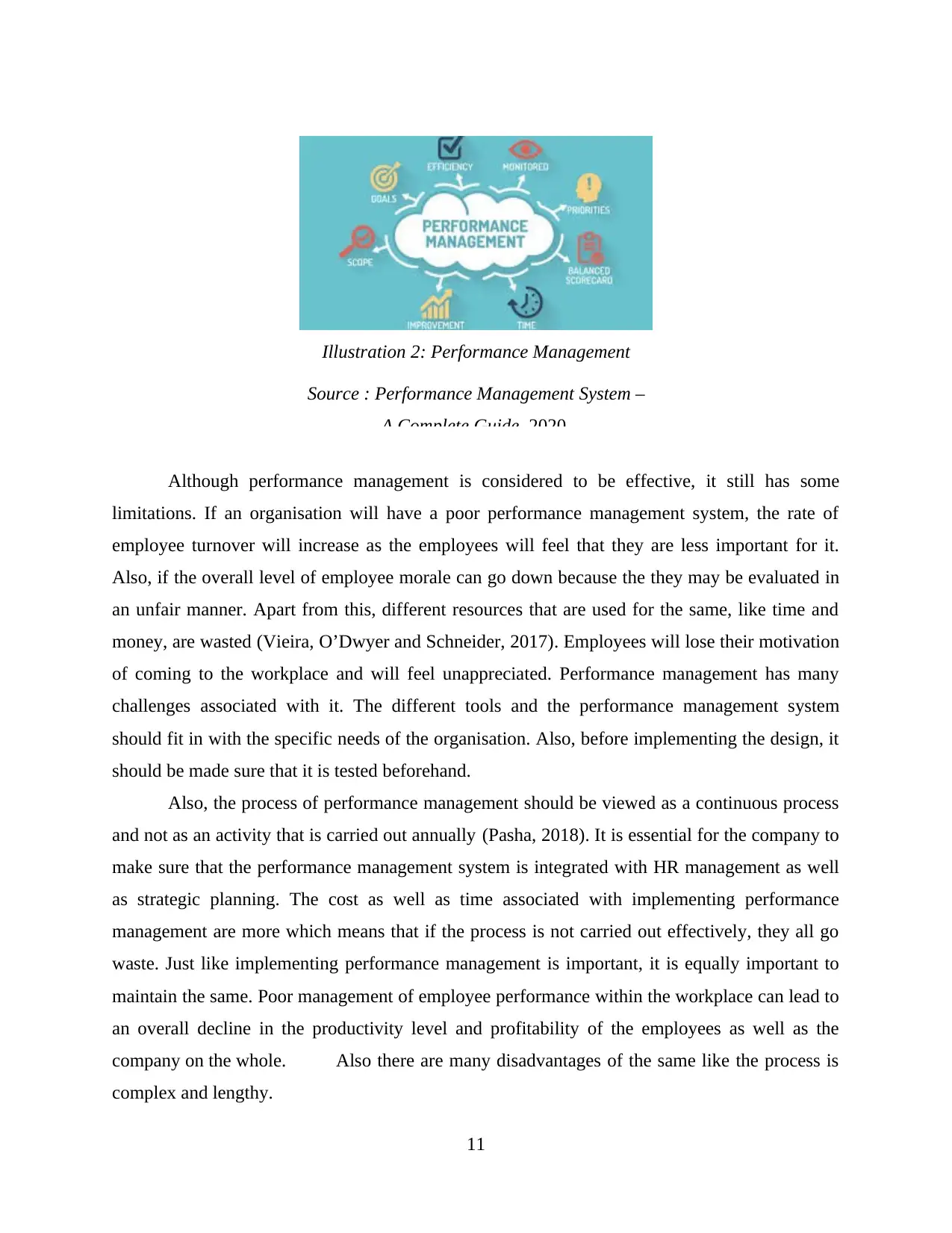
Although performance management is considered to be effective, it still has some
limitations. If an organisation will have a poor performance management system, the rate of
employee turnover will increase as the employees will feel that they are less important for it.
Also, if the overall level of employee morale can go down because the they may be evaluated in
an unfair manner. Apart from this, different resources that are used for the same, like time and
money, are wasted (Vieira, O’Dwyer and Schneider, 2017). Employees will lose their motivation
of coming to the workplace and will feel unappreciated. Performance management has many
challenges associated with it. The different tools and the performance management system
should fit in with the specific needs of the organisation. Also, before implementing the design, it
should be made sure that it is tested beforehand.
Also, the process of performance management should be viewed as a continuous process
and not as an activity that is carried out annually (Pasha, 2018). It is essential for the company to
make sure that the performance management system is integrated with HR management as well
as strategic planning. The cost as well as time associated with implementing performance
management are more which means that if the process is not carried out effectively, they all go
waste. Just like implementing performance management is important, it is equally important to
maintain the same. Poor management of employee performance within the workplace can lead to
an overall decline in the productivity level and profitability of the employees as well as the
company on the whole. Also there are many disadvantages of the same like the process is
complex and lengthy.
11
Illustration 2: Performance Management
Source : Performance Management System –
A Complete Guide, 2020.
limitations. If an organisation will have a poor performance management system, the rate of
employee turnover will increase as the employees will feel that they are less important for it.
Also, if the overall level of employee morale can go down because the they may be evaluated in
an unfair manner. Apart from this, different resources that are used for the same, like time and
money, are wasted (Vieira, O’Dwyer and Schneider, 2017). Employees will lose their motivation
of coming to the workplace and will feel unappreciated. Performance management has many
challenges associated with it. The different tools and the performance management system
should fit in with the specific needs of the organisation. Also, before implementing the design, it
should be made sure that it is tested beforehand.
Also, the process of performance management should be viewed as a continuous process
and not as an activity that is carried out annually (Pasha, 2018). It is essential for the company to
make sure that the performance management system is integrated with HR management as well
as strategic planning. The cost as well as time associated with implementing performance
management are more which means that if the process is not carried out effectively, they all go
waste. Just like implementing performance management is important, it is equally important to
maintain the same. Poor management of employee performance within the workplace can lead to
an overall decline in the productivity level and profitability of the employees as well as the
company on the whole. Also there are many disadvantages of the same like the process is
complex and lengthy.
11
Illustration 2: Performance Management
Source : Performance Management System –
A Complete Guide, 2020.
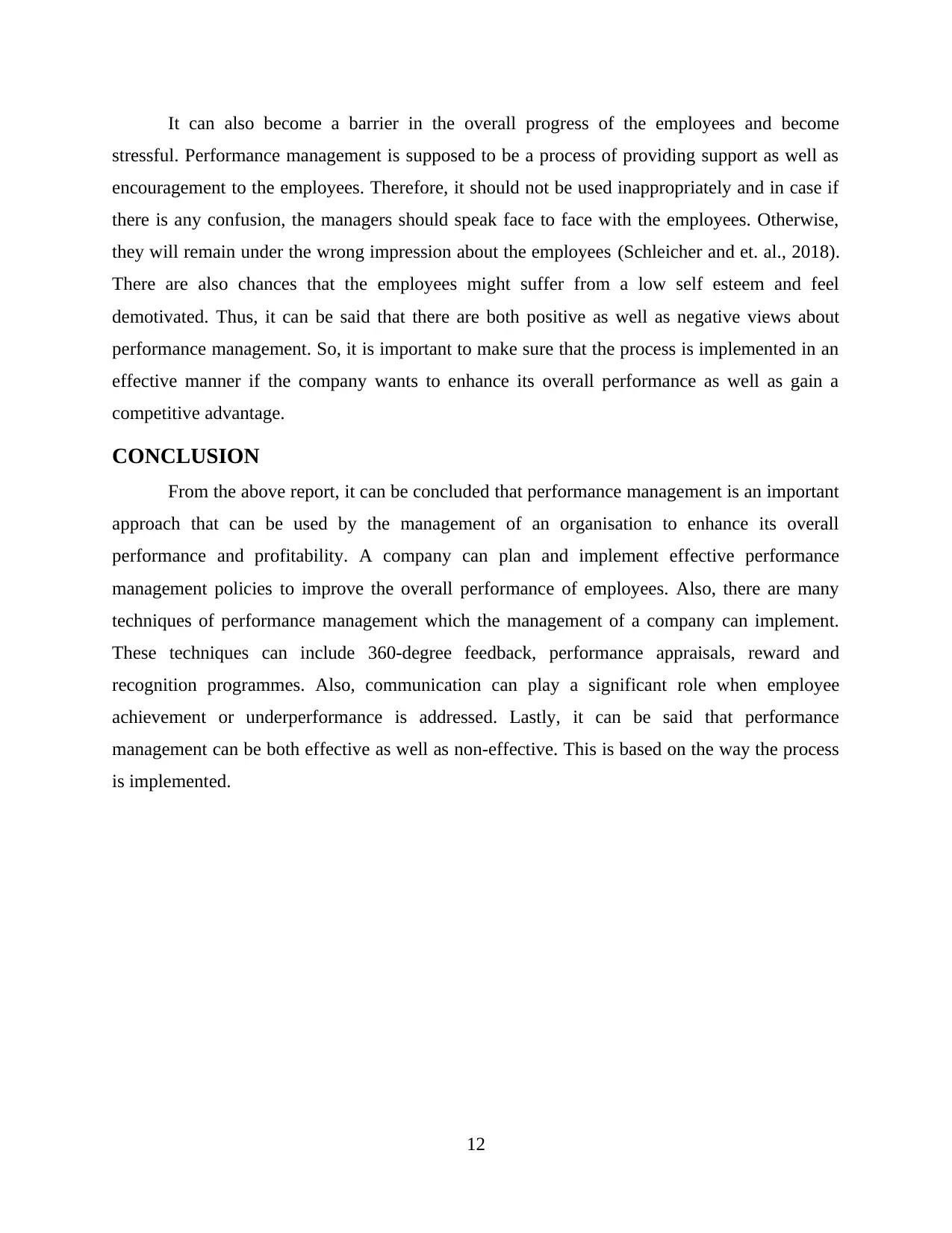
It can also become a barrier in the overall progress of the employees and become
stressful. Performance management is supposed to be a process of providing support as well as
encouragement to the employees. Therefore, it should not be used inappropriately and in case if
there is any confusion, the managers should speak face to face with the employees. Otherwise,
they will remain under the wrong impression about the employees (Schleicher and et. al., 2018).
There are also chances that the employees might suffer from a low self esteem and feel
demotivated. Thus, it can be said that there are both positive as well as negative views about
performance management. So, it is important to make sure that the process is implemented in an
effective manner if the company wants to enhance its overall performance as well as gain a
competitive advantage.
CONCLUSION
From the above report, it can be concluded that performance management is an important
approach that can be used by the management of an organisation to enhance its overall
performance and profitability. A company can plan and implement effective performance
management policies to improve the overall performance of employees. Also, there are many
techniques of performance management which the management of a company can implement.
These techniques can include 360-degree feedback, performance appraisals, reward and
recognition programmes. Also, communication can play a significant role when employee
achievement or underperformance is addressed. Lastly, it can be said that performance
management can be both effective as well as non-effective. This is based on the way the process
is implemented.
12
stressful. Performance management is supposed to be a process of providing support as well as
encouragement to the employees. Therefore, it should not be used inappropriately and in case if
there is any confusion, the managers should speak face to face with the employees. Otherwise,
they will remain under the wrong impression about the employees (Schleicher and et. al., 2018).
There are also chances that the employees might suffer from a low self esteem and feel
demotivated. Thus, it can be said that there are both positive as well as negative views about
performance management. So, it is important to make sure that the process is implemented in an
effective manner if the company wants to enhance its overall performance as well as gain a
competitive advantage.
CONCLUSION
From the above report, it can be concluded that performance management is an important
approach that can be used by the management of an organisation to enhance its overall
performance and profitability. A company can plan and implement effective performance
management policies to improve the overall performance of employees. Also, there are many
techniques of performance management which the management of a company can implement.
These techniques can include 360-degree feedback, performance appraisals, reward and
recognition programmes. Also, communication can play a significant role when employee
achievement or underperformance is addressed. Lastly, it can be said that performance
management can be both effective as well as non-effective. This is based on the way the process
is implemented.
12
⊘ This is a preview!⊘
Do you want full access?
Subscribe today to unlock all pages.

Trusted by 1+ million students worldwide
1 out of 15
Related Documents
Your All-in-One AI-Powered Toolkit for Academic Success.
+13062052269
info@desklib.com
Available 24*7 on WhatsApp / Email
![[object Object]](/_next/static/media/star-bottom.7253800d.svg)
Unlock your academic potential
Copyright © 2020–2025 A2Z Services. All Rights Reserved. Developed and managed by ZUCOL.





